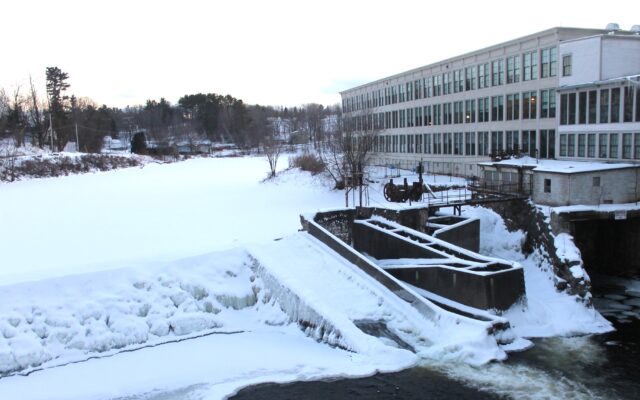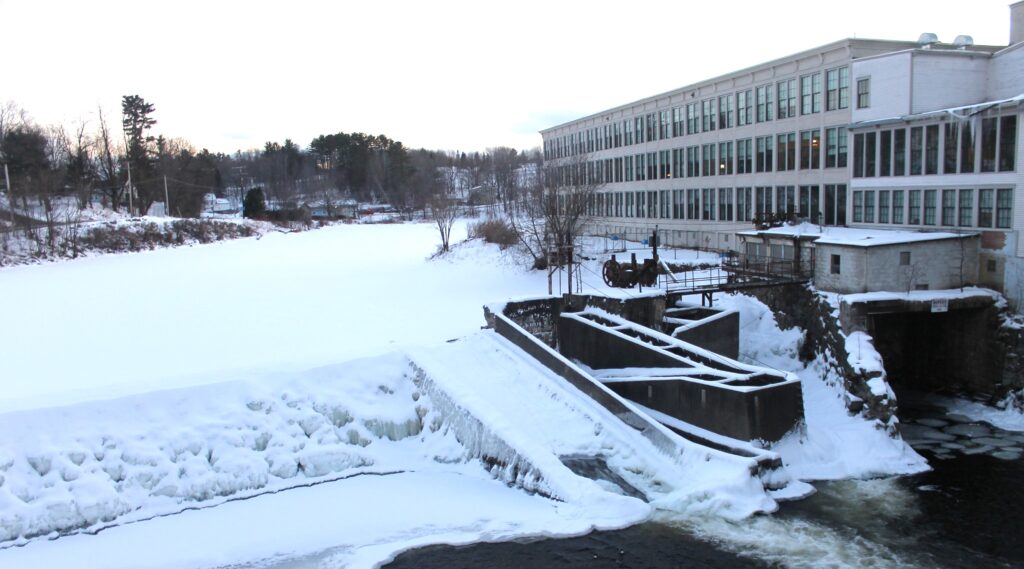
Dover-Foxcroft looking at the future of the Mayo Mill Dam
DOVER-FOXCROFT — Dover-Foxcroft voters rejected a referendum article last June concerning removal of the downtown Mayo Mill Dam on the Piscataquis River, indicating they were in favor of using tax money to fund studies, permitting, and repair costs for the structure.
The Mayo Mill Dam Review Committee was formed to help determine the future of the site. By June 30, the town needs to not only make a decision on whether to pursue hydropower, but also a plan that will repair the dam, make it compliant with fish regulations, and more.
An extension for those decisions will likely be requested.
The dam committee held a public meeting on Tuesday, Feb. 4, at the Central Hall Commons to give an update on its review of the redevelopment of the dam and hydrofacility.

MAYO MILL DAM — The Mayo Mill Dam Committee is working to determine a plan for the structure on the Piscataquis River in downtown Dover-Foxcroft.
The group was tasked with “dam fact finding, what it would take to keep the dam, and what all our options are,” Committee Chair/Select Board Vice Chair Steve Grammont said. The committee is not a decision-making body, he said, but will present its findings to the select board and people of the town.
Realistic options were looked at, and discussions had to include the costs, which heading in were estimated to be well into the millions, Grammont said. The only recommendation so far is that bringing back hydropower at the Mayo Mill Dam was not worth pursuing.
“It’s not economically viable to restart power,” Grammont said.
The town previously consulted with multiple engineers, turbine suppliers and a private developer for years to try to identify a hydropower retrofit. When the Arnold Development Group of Kansas City, Missouri, converted the former mill building into apartments and office space, the consultants looked at restoring hydropower and had an application submitted to the Federal Energy Regulatory Commission about a half decade ago but did not pursue it further.
With a slideshow projected for the audience, dam committee member Chris Maas said a study by Gomez and Sullivan Engineers found deficiencies in the dam, many of which FERC had previously identified. The findings had the dam repairs, improvements to the powerhouse, and installation of post-tensioned rock anchors totaling between $2,026,000 and $2,460,000. With other repair costs included, the price rises to between $4.3 million and $4,766,000, Maas said.
With a $1.1 million fishway (the current fishway is not in compliance and needs to be replaced), $1.4 million for contingency, and $1.4 million for project delivery the costs would be $7,693,767, Maas said.
The dam and powerhouse are licensed under FERC, and either a license amendment or license surrender will need to be filed, he added.
“A reasonable time to do this is about a year,” Maas said, saying all this is the town’s responsibility.
He gave an estimate of a minimum of five years to carry out all the dam work he had mentioned.
Dam committee member Bill Erspamer discussed power generation and dam remediation.
“The existing turbine is not usable, the existing powerhouse is a mess,” he said, noting that the building needs to either be repaired or replaced. Power has not been generated at the site in 18 years.
The fishway needs to be considered when looking at turbines, Erspamer said, as these cannot run continually due to times of the day and the year when fish are moving in the Piscataquis River. He said a new fishway would interfere with a new turbine.
A 300 kilowatt turbine is the largest that could be installed, but this would not run 24/7. A typical yield is 50 percent, and Kleinschmidt Associates of Pittsfield put the site yield at 51.7 percent for 1,360 megawatts of power that could be sold, Erspamer said.
The wholesale price of power is $35 a megawatt hour and the net metering price is $135 a megawatt hour. The dam site could qualify for the larger price by being a small renewable power system. Under net metering, electricity is credited to power used at another site but all of Dover-Foxcroft’s municipal electricity is already covered by contract, so net metering is not available, Erspamer said. A user would need to be found, otherwise power generated by the river would only be at the wholesale price.
The annual revenues would be $48,000 or $185,000 under the two options, $18,000 and $155,000 after the $30,000 in yearly operating costs, he said.
“To put in a powerhouse arrangement would be $3.2 million with everything,” Erspamer said, with these expenses being separate from dam repairs.
“We are not doing these projects today, we are looking at years to install a powerhouse,” he said, mentioning inflation between now and a half decade into the future.
Mentioning a $2,071,000 net cost to the town and a 25-year bond with 5 percent interest rate, Erspamer said the annual net cost would be $71,000. He said for a $200,000 property the tax increase would be $38 a year.
“Only for installing and maintaining a powerhouse for the next 25 years,” Erspamer said. “The committee voted to not recommend resuming power generation at the dam.”
Speaking of dam remediation, he said the structure must be repaired whether it is licensed or not and no major repairs have been done in two decades. Remediation consists of the FERC repairs, powerhouse removal, and fish ladder installation, Erspamer said.
The full project costs, including construction, delivery, town overhead, and an inflation rate of 2.7 percent a year is $9,890,000, Erspamer said. This is divided into about $6.6 million for dam repairs, $380,000 for powerhouse removal, and nearly $2.9 million for fish ladder installation.
Should the $9.8 million be financed for 25 years with a 5 percent interest rate, then the cost would be just more than $16 million, coming to $727,000 a year over a quarter century. For a $200,000 property the tax increase would be $388, Erspamer said.
“These are tough numbers and we have no real good reason to dispute them,” committee member Sandy Perkins said.
Project funding sources could include property taxes, some of 10 to 15 federal and state grant programs, a Maine Revolving Loan Fund that Gov. Janet Mills may extend to include dam works, private donations, and community fundraising, Perkins said.
Perkins mentioned a hypothetical figure of $3,266,000 in external funding could bring the annual tax increase for a $200,000 property down to $264 from $388.
Next, the group will meet to continue its discussions and at a later time report to the select board with official recommendations, committee member Sean Hadley said.
An extension with FERC will need to be negotiated as the end of June deadline is unlikely to be met.
When asked about financial commitments for this year, Grammont said the decisions are up to the select board, but he said there likely will need to be several thousand dollars in expenditures in 2025. These may include legal work, a request for proposals for a FERC consultant, another RFP for engineering work, and a consultant for state and federal fish and wildlife.
Citizens have not yet voted on any plans to fix the dam.
“That’s where we’re headed next,” Grammont said.